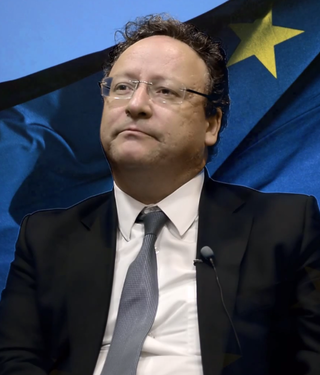Top Qs
Timeline
Chat
Perspective
2014 European Parliament election in Portugal
From Wikipedia, the free encyclopedia
Remove ads
An election was held in Portugal on Sunday, 25 May 2014, to elect the Portuguese delegation to the European Parliament from 2014 to 2019. This was the seventh European Parliament election held in Portugal.
The Socialist Party (PS) was the winner of the elections, scoring 31.5 percent of the votes. The Socialists increased their share of vote by almost 5 percentage points, and won one more seat compared with 2009. However, the PS victory was much more weaker than what polls predicted, as the margin between them and the Social Democratic Party (PSD) and CDS – People's Party (CDS) coalition was below 4 points. Because of this worse than expected result, the PS would enter in a leadership contest just weeks after the election.
The PSD/CDS contested the election in a coalition called "Portugal Alliance". The coalition achieved one of the worst results ever, as PSD+CDS never polled below 30 percent, but the weak result by the coalition was softened by the close margin between them and the Socialists.
The Democratic Unity Coalition (CDU) scored their best result since 1989, polling almost 13 percent of the vote and winning one more seat compared with 2009. On the other hand, the Left Bloc (BE) suffered a huge defeat by erasing their 2009 historic results. The BE won 4.6 percent of the votes, a drop of more than 6 points, and was only able to elect their top candidate Marisa Matias, compared with the three seats they won in 2009.
The big surprise of the elections was the extraordinary result of the Earth Party (MPT). Headed by the former bar association chairman António Marinho e Pinto, MPT won 7.2 percent of the votes and was able to elect two members to the European Parliament. To add also, that LIVRE, headed by BE dissident Rui Tavares, was not able to win a seat, although scoring 2.2 percent.
Turnout fell to the lowest level ever, with only 33.7 percent of voters casting a ballot.
Remove ads
Electoral system
The voting method used, for the election of European members of parliament, is by proportional representation using the d'Hondt method, which is known to benefit leading parties. In the 2014 European Union elections, Portugal had 21 seats to be filled. Deputies are elected in a single constituency, corresponding to the entire national territory.
Parties and candidates
The major parties that participated in the election, and their European Parliament list leaders, were:
- Left Bloc (BE), Marisa Matias
- Democratic Unity Coalition (CDU), João Ferreira
- Socialist Party (PS), Francisco Assis
- Social Democratic Party (PSD)/People's Party (CDS–PP) Aliança Portugal, Paulo Rangel
- LIVRE (L), Rui Tavares
- Socialist Alternative Movement (MAS), Gil Garcia
- Earth Party (MPT), António Marinho e Pinto
- Party for Animals and Nature (PAN), Orlando Figueiredo
- Portuguese Workers' Communist Party (PCTP/MRPP), Leopoldo Mesquita
- Democratic Party of the Atlantic (PDA), Paulo Casaca
- New Democracy Party (PND), Eduardo Welsh
- National Renovator Party (PNR), Humberto Nuno de Oliveira
- Workers Party of Socialist Unity (POUS), Carmelinda Pereira
- People's Monarchist Party (PPM), Nuno Correia da Silva
- Portugal Pro-Life (PPV), Acácio Valente
- Portuguese Labour Party (PTP), José Manuel Coelho
The Social Democratic Party and the People's Party have contested this election in a coalition.[4]
Remove ads
Campaign period
Party slogans
Candidates' debates
Opinion polling
Summarize
Perspective
Exit poll
Remove ads
Voter turnout
The table below shows voter turnout throughout election day including voters from Overseas.
National summary of votes and seats
Distribution by European group
Maps
- Most voted political force by district.
- Strongest party by municipality. Pink: PS; Darkblue: PSD-CDS; Red: CDU
Remove ads
See also
References
External links
Wikiwand - on
Seamless Wikipedia browsing. On steroids.
Remove ads









